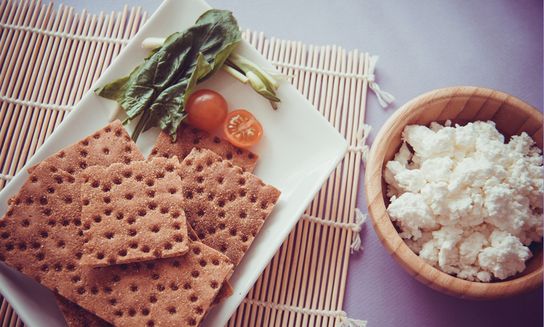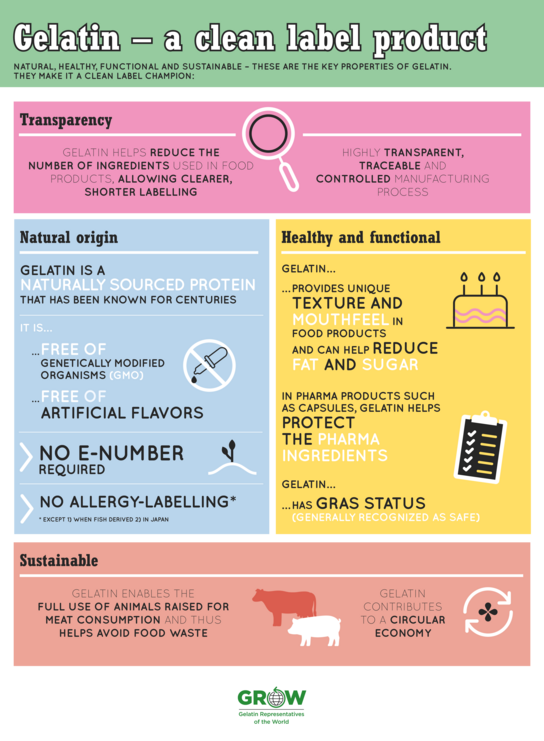Gelatin is indispensable for the food industry and for nutrition

Gelatin is a high-quality ingredient and has many positive properties as a foodstuff. Thanks to its gelling ability, gelatin is indispensable in modern cuisine. Also, foam formation, stabilization and texturizing are essential properties in the creation of tasty desserts. Gelatin is also a source of protein. It can effectively replace carbohydrates and fat in many foods and is thus better suited to meet nutritional needs.
The invention of tinned food by Nicolas Appert and the invention of artificial refrigeration are not the only milestones of 19th century culinary art. The industrial production of gelatin also paved the way for new possibilities in cooking, and that to an extent previously not thought possible. However, this natural foodstuff is in fact several centuries old. Sources show that humans have been using and appreciating gelatin for millennia.
Gelatin-like mixtures were already being produced in Egypt during Pharaonic times. Written records have shown that fish and fruit specialties prepared with gelatin were considered absolute delicacies and served at feasts. Gelatin’s great triumph, however, really only began in the 19th century.
Around this time the first small businesses sprang up that were able to produce gelatin on a larger scale. A milestone that had a great impact on the culinary arts.
And so, today gelatin has many diverse applications in modern food production. Gelatin is always used when a natural ingredient with multifunctional properties is needed to keep products in a certain form.
Aside from its being completely natural, one advantage it offers is its unique ability to react to heat. Products that are made with gelatin melt at body temperature and set again as they cool.
This is why products that contain gelatin melt in the mouth, guaranteeing an ideal discharge of their flavor. Gelatin’s pleasing properties make it indispensable for the food sector.
It contains no cholesterol, sugar or fat and is easy to digest.


Gelatin also offers many benefits for the preparation of products that are low in fat, sugar and calories. It makes it easy to develop diet products that still offer the same amount of flavor and texture as their full-fat counterparts. For example, gelatin is added to curd cheese to improve texture, stabilize emulsions, reduce calories and build up foam (less weight at the same volume). In meat products such as hot dogs, tinned meat or sausages, gelatin adds consistency, enhances aroma, improves sensory properties and reduces the fat content.
Edible gelatin is indispensable for the production of many delicacies, including jelly babies, wine gums, chewy candies, fruit drops, marshmallows, licorice and chocolate marshmallows. Gelatin ensures elasticity, the proper chew effect and a longer shelf life. It forms and stabilizes foam for light and airy sweets, thus facilitating the transport and storage of products.
A fancy cake without gelatin? Practically unthinkable. Fancy cakes are easier to slice because gelatin stabilizes buttercream or cream fillings. Furthermore, gelatin also extends their shelf life. Powdered, leaf or instant gelatin makes it easy to freeze and thaw industrially manufactured fancy cakes.
Gelatin plays an extremely important role in the preparation and development of new varieties of milk products and desserts. The right amount and the right type of gelatin result in light and creamy yogurts or variations of other common milk products such as quark, kefir or ice cream. Be they firm or fluffy and light: gelatin achieves the desired consistency for cream and mousse desserts and makes sure they melt deliciously in the mouth. Gelatin also makes the refreshing jelly dessert transparent and “wiggly”.
Gelatin ensures that pâtés and jellied meats look appetizing. A coating of gelatin keeps many salami or spicy Pfefferwurst sausage variations (a sausage made from beef and peppers) from drying out. In the fish processing industry, gelatin is mainly used for jelly products, whereby it protects the products from light and oxygen and enhances their appearance. Special types of gelatin are becoming increasingly important because they increase the protein concentration in pâtés, ready-made meals and other delicacies.
Gelatin as an important source of protein
Today, through our eating habits, we take in excessive amounts of fat and carbohydrates and far too little protein. Gelatin can effectively replace carbohydrates and fat in many foods and is thus better suited to meeting nutritional needs. Furthermore, protein contributes to a better energy homeostasis than carbohydrates and fat, so that replacing them with gelatin leads to a lower intake of energy.
Low-fat and reduced-calorie products
Gelatin can play an important role in the preparation of low-fat or reduced-fat meals. Due to its ability to form an oil-in-water emulsion, it can be used to partially replace the high fat content in many products. Without gelatin, it would have been impossible to develop many of the low-fat products such as half-fat margarine, reduced-fat cheeses or yogurt variations that are found as light products on store shelves today. Gelatin adds volume to these products. It binds water in the final product, thereby increasing the volume without adding further calories. Despite the significant reduction in fat, gelatin’s properties ensure that these kinds of products still offer the same type of flavor that fat would have added and melt deliciously in the mouth.
Many reduced-calorie foods are not as enjoyable as comparable products with the “normal” number of calories, which often leads to lower acceptance on the part of consumers. Gelatin is ideal for the development of high-quality, reduced-calorie products such as low-fat ice cream, milk products, cakes and pastries.
True or false? “Gelatin helps with weight loss!” The #BustingGelatinMyths series tackles common myths about gelatin. This video gives surprising insights how the natural foodstuff supports a balanced diet.
Want to learn more about gelatin’s unique properties and advantages?
Expectations are high when it comes to the so-called light products. Despite the reduction in fat, the creamy structure of such products as low-fat ice cream or the consistency and typical development of flavor of reduced-fat margarine are to be retained. In order to achieve this, manufacturers have come to rely on the emulsion-building and water-binding properties of gelatin.
Water can replace fat in the production of reduced-fat products. Water does not contain any calories but must be structured and stabilized within the microstructure of the product. This is where gelatin comes in, because it can bind and stabilize large amounts of water. Special types of gelatin and techniques are used to structure water into small, fat-like drops. This makes it possible to form so-called water-in-water emulsions in products with a high water fraction and manufacture products with a creamy texture. The result is that, although the product contains less fat and fewer calories, it continues to melt deliciously in the mouth. Moreover, gelatin ensures that these products have the same characteristically soft and creamy consistency as full-fat products. Thus, the only difference between them and full-fat products is the fat content.
Scientific findings have shown that people who follow a diet with a low glycaemic index (GI) have a significantly lower risk of developing type 2 diabetes or coronary heart disease. The GI level of products is dependent upon the proportion of carbohydrates, especially sugar. This is why the current trend is moving towards reducing or leaving out sugar, even in sweets.
Sugar as a “source of flavor” plays an important role in the sweetness of many products. Leaving the sugar out makes it necessary to find a replacement not only in terms of quantity, but also with regard to its function. Otherwise, a lack of sugar will lead to a loss of flavor and consistency. A blend of gelatin and sweeteners can help meet these requirements. The recommended daily intake of most of the other common bulk sweeteners available today is restricted because they can have a laxative effect. Examples of products that consumers are very familiar with are reduced-sugar fruit gums and chewy candies that are rich in protein.
Sugar is also used as a kind of natural “adhesive”, for example for cereal bars, where it binds individual ingredients such as cornflakes and raisins and gives the bars their shape. Gelatin can also be used as a binding agent in this case, which effectively cuts calories and reduces sweetness – without any loss of quality.
All in all, thanks to its versatile properties, gelatin is indispensable for the production of optimized foods that meet the special requirements of many consumers, i.e. low in fat, sugar and calories, but without any need for compromise in terms of flavor and texture.
Clean Labelling
Today, consumers are paying ever closer attention to the ingredients used in the products they consume, which means that natural and healthy ingredients are playing an increasingly important role in the decisions they make to purchase certain foods. Many consumers refuse to use artificial or genetically modified ingredients, or ingredients that have an E number. As a natural foodstuff, gelatin is the ideal alternative when it comes to finding a replacement for a wide variety of ingredients.


